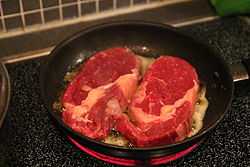Entrecôte
.jpg)
In French, the word entrecôte (French pronunciation: [ɑ̃.tʁə.kot]) denotes a premium cut of beef used for steaks.
A traditional entrecôte comes from the rib area of the carcass, corresponding to the steaks known in different parts of the English-speaking world as rib, rib-eye, club, Scotch fillet, or Delmonico.
The term may also be used in France to denote the sirloin cut properly known as a contre-filet,[1][2] being the portion of the sirloin on the opposite side of the bone from the filet, or tenderloin. In English, a steak cut from the contre-filet may be called a Porterhouse steak (as the term is understood in Australia, New Zealand, and the United Kingdom), a sirloin steak, a strip steak, a striploin steak, a wing steak, a club steak, a Delmonico steak, or a New York steak. (As well, if the contre-filet is left on the bone with the filet, the entire steak is called a Porterhouse steak (as the term is understood in the United States and Canada) or a T-bone steak.)
.jpg)

See also
- Cuts of beef by nation
- Entrecôte Café de Paris
References
External links
| Wikimedia Commons has media related to Entrecôte. |
| Look up entrecôte in Wiktionary, the free dictionary. |